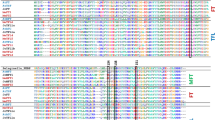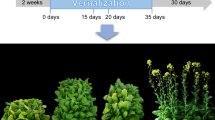Key message
The field survey in this article showed in ‘KU50’, a popular variety and late-branching type of cassava in Southeast Asia, that flowering rarely occurs in normal-field conditions in Southeast Asia but is strongly induced in the dry season in the mountainous region. Flowering time is correlated with the expression patterns of MeFT1 and homologs of Arabidopsis GI, PHYA, and NF-Ys.
Abstract
Cassava (Manihot esculenta Crantz) is a tropical crop that is propagated vegetatively rather than sexually by seed. Flowering rarely occurs in the erect-type variety grown in Southeast Asia, but it is known that cassava produces flowers every year in mountainous regions. Data pertaining to the effect of environmental factors on flowering time and gene expression in cassava, however, is limited. The aim of the present study was to determine the kinds of environmental conditions that regulate flowering time in cassava and the underlying molecular mechanisms. The flowering status of KU50, a popular variety in Southeast Asia and late-branching type of cassava, was monitored in six fields in Vietnam and Cambodia. At non-flowering and flowering field locations in North Vietnam, the two FLOWERING LOCUS T (FT)-like genes, MeFT1 and MeFT2, were characterized by qPCR, and the pattern of expression of flowering-related genes and genes responsive to environmental signals were analyzed by using RNA sequencing data from time-series samples. Results indicate that cassava flowering was induced in the dry season in the mountain region, and that flowering time was correlated with the expression of MeFT1, and homologs of Arabidopsis GI, PHYA, and NF-Ys. Based upon these data, we hypothesize that floral induction in cassava is triggered by some conditions present in the mountain regions during the dry season.






Similar content being viewed by others
References
Adeyemo OS, Chavarriaga P, Tohme J, Fregene M, Davis SJ, Setter TL (2017) Overexpression of Arabidopsis FLOWERING LOCUS T (FT) gene improves floral development in cassava (Manihot esculenta, Crantz). PLoS ONE 12:e0181460. https://doi.org/10.1371/journal.pone.0181460
Adeyemo OS, Hyde PT, Setter TL (2019) Identification of FT family genes that respond to photoperiod, temperature and genotype in relation to flowering in cassava (Manihot esculenta, Crantz). Plant Reprod 32:181–191. https://doi.org/10.1007/s00497-018-00354-5
Alonso JM, Hirayama T, Roman G, Nourizadeh S, Ecker JR (1999) EIN2, a bifunctional transducer of ethylene and stress responses in Arabidopsis. Science 284:2148–2152. https://doi.org/10.1126/science.284.5423.2148
Aziz ZA (1984) Observations on the effect of low temperature on floral induction in cassava MARDI Research Bulletin (Malaysia)
Blumel M, Dally N, Jung C (2015) Flowering time regulation in crops-what did we learn from Arabidopsis? Curr Opin Biotechnol 32:121–129. https://doi.org/10.1016/j.copbio.2014.11.023
Bull SE, Alder A, Barsan C, Kohler M, Hennig L, Gruissem W, Vanderschuren H (2017) FLOWERING LOCUS T triggers early and fertile flowering in glasshouse cassava (Manihot esculenta Crantz). Plants (Basel). https://doi.org/10.3390/plants6020022
Ceballos H, Iglesias CA, Perez JC, Dixon AG (2004) Cassava breeding: opportunities and challenges. Plant Mol Biol 56:503–516. https://doi.org/10.1007/s11103-004-5010-5
Ceballos H, Jaramillo J, Salazar S, Pineda L, Calle F, Setter T (2017) Induction of flowering in cassava through grafting. J Plant Breed Crop Sci 9:19–29. https://doi.org/10.5897/jpbcs2016.0617
Cerdan PD, Chory J (2003) Regulation of flowering time by light quality. Nature 423:881–885. https://doi.org/10.1038/nature01636
Chavarriaga-Aguirre P, Halsey M (2005) Cassava (Manihot esculenta Crantz): reproductive biology and practices for confinement of experimental field trials. In: Report prepared for the Program for Biosafety Systems., Washington, D.C.: Program for Biosafety Systems
Cho LH, Yoon J, An G (2017) The control of flowering time by environmental factors. Plant J 90:708–719. https://doi.org/10.1111/tpj.13461
Corbesier L et al (2007) FT protein movement contributes to long-distance signaling in floral induction of Arabidopsis. Science 316:1030–1033. https://doi.org/10.1126/science.1141752
FAO (2013) Save and grow: cassava A guide to sustainable production intensification
Finkelstein R (2013) Abscisic acid synthesis and response. Arabidopsis Book 11:e0166. https://doi.org/10.1199/tab.0166
Fornara F, de Montaigu A, Coupland G (2010) SnapShot: control of flowering in Arabidopsis. Cell 141:550, 550 e551–552. https://doi.org/10.1016/j.cell.2010.04.024
Fowler S et al (1999) GIGANTEA: a circadian clock-controlled gene that regulates photoperiodic flowering in Arabidopsis and encodes a protein with several possible membrane-spanning domains. EMBO J 18:4679–4688. https://doi.org/10.1093/emboj/18.17.4679
Guillaumot D et al (2009) The Arabidopsis TSPO-related protein is a stress and abscisic acid-regulated, endoplasmic reticulum-Golgi-localized membrane protein. Plant J 60:242–256. https://doi.org/10.1111/j.1365-313X.2009.03950.x
Hershey CH (1987) Cassava breeding: a multidisciplinary review. CIAT, Cali
Howeler RH, Maung Aye T (2014) Sustainable management of cassava in Asia from research to practice. International Center for Tropical Agriculture (CIAT); The Nippon Foundation, p 168
Inigo S, Alvarez MJ, Strasser B, Califano A, Cerdan PD (2012) PFT1, the MED25 subunit of the plant Mediator complex, promotes flowering through CONSTANS dependent and independent mechanisms in Arabidopsis. Plant J 69:601–612. https://doi.org/10.1111/j.1365-313X.2011.04815.x
Keating BA, Evenson JP, Fukai S (1982) Environmental effects on growth and development of cassava (Manihot esculenta Crantz.) I Crop development. Field Crops Res 5:271–281. https://doi.org/10.1016/0378-4290(82)90030-2
Kim SY (2005) The role of ABF family bZIP class transcription factors in stress response. Physiologia Plant 126:527. https://doi.org/10.1111/j.1399-3054.2005.00601.x
Kobayashi MJ, Takeuchi Y, Kenta T, Kume T, Diway B, Shimizu KK (2013) Mass flowering of the tropical treeShorea beccarianawas preceded by expression changes in flowering and drought-responsive genes. Mol Ecol 22:4767–4782. https://doi.org/10.1111/mec.12344
Laubinger S et al (2006) Arabidopsis SPA proteins regulate photoperiodic flowering and interact with the floral inducer CONSTANS to regulate its stability. Development 133:4608–4608. https://doi.org/10.1242/dev.02691
Leonardo SS, Diniz RP, Neves RdJ, Alves AAC, Eder JdO (2018) Grafting as a strategy to increase flowering of cassava. Sci Hortic 240:544–551. https://doi.org/10.1016/j.scienta.2018.06.070
Li W, Herrera-Estrella L, Tran LP (2016) The Yin-Yang of cytokinin homeostasis and drought acclimation/adaptation. Trends Plant Sci 21:548–550. https://doi.org/10.1016/j.tplants.2016.05.006
Liu H et al (2013) Arabidopsis CRY2 and ZTL mediate blue-light regulation of the transcription factor CIB1 by distinct mechanisms. Proc Natl Acad Sci USA 110:17582–17587. https://doi.org/10.1073/pnas.1308987110
Liu H, Yu X, Li K, Klejnot J, Yang H, Lisiero D, Lin C (2008) Photoexcited CRY2 interacts with CIB1 to regulate transcription and floral initiation in Arabidopsis. Science 322:1535–1539. https://doi.org/10.1126/science.1163927
Luo X et al (2018) The NUCLEAR FACTOR-CONSTANS complex antagonizes Polycomb repression to de-repress FLOWERING LOCUS T expression in response to inductive long days in Arabidopsis. Plant J 95:17–29. https://doi.org/10.1111/tpj.13926
Mockler T, Yang H, Yu X, Parikh D, Yc C, Dolan S, Lin C (2003) Regulation of photoperiodic flowering by Arabidopsis photoreceptors. Proc Natl Acad Sci 100:2140–2145. https://doi.org/10.1073/pnas.0437826100
Nguyen KH et al (2016) Arabidopsis type B cytokinin response regulators ARR1, ARR10, and ARR12 negatively regulate plant responses to drought. Proc Natl Acad Sci USA 113:3090–3095. https://doi.org/10.1073/pnas.1600399113
Nishizawa A, Yabuta Y, Shigeoka S (2008) Galactinol and raffinose constitute a novel function to protect plants from oxidative damage. Plant Physiol 147:1251–1263. https://doi.org/10.1104/pp.108.122465
Olasanmi B (2018) Crossability among five cassava (Manihot Esculenta CRANTZ) varieties. Mod Concepts Dev Agron. https://doi.org/10.31031/mcda.2018.02.000543
Panikulangara TJ, Eggers-Schumacher G, Wunderlich M, Stransky H, Schoffl F (2004) Galactinol synthase1. A novel heat shock factor target gene responsible for heat-induced synthesis of raffinose family oligosaccharides in Arabidopsis. Plant Physiol 136:3148–3158. https://doi.org/10.1104/pp.104.042606
Petroni K et al (2012) The promiscuous life of plant NUCLEAR FACTOR Y transcription factors. Plant Cell 24:4777–4792. https://doi.org/10.1105/tpc.112.105734
Poethig RS (1990) Phase change and the regulation of shoot morphogenesis in plants. Science 250:923–930. https://doi.org/10.1126/science.250.4983.923
Putterill J, Robson F, Lee K, Simon R, Coupland G (1995) The CONSTANS gene of Arabidopsis promotes flowering and encodes a protein showing similarities to zinc finger transcription factors. Cell 80:847
Rasheed S, Bashir K, Matsui A, Tanaka M, Seki M (2016) Transcriptomic analysis of soil-grown Arabidopsis thaliana roots and shoots in response to a drought stress. Front Plant Sci 7:180. https://doi.org/10.3389/fpls.2016.00180
Riboni M, Galbiati M, Tonelli C, Conti L (2013) GIGANTEA enables drought escape response via abscisic acid-dependent activation of the florigens and SUPPRESSOR OF OVEREXPRESSION OF CONSTANS. Plant Physiol 162:1706–1719. https://doi.org/10.1104/pp.113.217729
Riboni M, Robustelli Test A, Galbiati M, Tonelli C, Conti L (2016) ABA-dependent control of GIGANTEA signalling enables drought escape via up-regulation of FLOWERING LOCUS T in Arabidopsis thaliana. J Exp Bot 67:6309–6322. https://doi.org/10.1093/jxb/erw384
Rock CD, Zeevaart JA (1991) The aba mutant of Arabidopsis thaliana is impaired in epoxy-carotenoid biosynthesis. Proc Natl Acad Sci 88:7496
Sawa M, Nusinow DA, Kay SA, Imaizumi T (2007) FKF1 and GIGANTEA complex formation is required for day-length measurement in Arabidopsis. Science 318:261–265. https://doi.org/10.1126/science.1146994
Shimizu KK, Kudoh H, Kobayashi MJ (2011) Plant sexual reproduction during climate change: gene function in natura studied by ecological and evolutionary systems biology. Ann Bot 108:777–787. https://doi.org/10.1093/aob/mcr180
Song YH et al (2018) Molecular basis of flowering under natural long-day conditions in Arabidopsis. Nat Plants 4:824–835. https://doi.org/10.1038/s41477-018-0253-3
Song YH, Shim JS, Kinmonth-Schultz HA, Imaizumi T (2015) Photoperiodic flowering: time measurement mechanisms in leaves. Annu Rev Plant Biol 66:441–464. https://doi.org/10.1146/annurev-arplant-043014-115555
Tamaki S, Matsuo S, Wong HL, Yokoi S, Shimamoto K (2007) Hd3a protein is a mobile flowering signal in rice. Science 316:1033–1036. https://doi.org/10.1126/science.1141753
Teotia S, Tang G (2015) To bloom or not to bloom: role of microRNAs in plant flowering. Mol Plant 8:359–377. https://doi.org/10.1016/j.molp.2014.12.018
Townsley BT, Covington MF, Ichihashi Y, Zumstein K, Sinha NR (2015) BrAD-seq: Breath Adapter Directional sequencing: a streamlined, ultra-simple and fast library preparation protocol for strand specific mRNA library construction. Front Plant Sci 6:366. https://doi.org/10.3389/fpls.2015.00366
Tsuji H, Taoka K, Shimamoto K (2011) Regulation of flowering in rice: two florigen genes, a complex gene network, and natural variation. Curr Opin Plant Biol 14:45–52. https://doi.org/10.1016/j.pbi.2010.08.016
Turck F, Fornara F, Coupland G (2008) Regulation and identity of florigen: FLOWERING LOCUS T moves center stage. Annu Rev Plant Biol 59:573–594. https://doi.org/10.1146/annurev.arplant.59.032607.092755
Utsumi Y, Utsumi C, Tanaka M, Ha VT, Matsui A, Takahashi S, Seki M (2017) Formation of friable embryogenic callus in cassava is enhanced under conditions of reduced nitrate, potassium and phosphate. PLoS ONE 12:e0180736. https://doi.org/10.1371/journal.pone.0180736
Valverde F (2004) Photoreceptor regulation of CONSTANS protein in photoperiodic flowering. Science 303:1003–1006. https://doi.org/10.1126/science.1091761
Whittaker C, Dean C (2017) The FLC locus: a platform for discoveries in epigenetics and Adaptation. Annu Rev Cell Dev Biol 33:555–575. https://doi.org/10.1146/annurev-cellbio-100616-060546
Wang W, Hostettler CE, Damberger FF, Kossmann J, Lloyd JR, Zeeman SC (2018) Modification of cassava root starch phosphorylation enhances starch functional properties. Front Plant Sci 9:1562
Yeoh SH et al (2017) Unravelling proximate cues of mass flowering in the tropical forests of South-East Asia from gene expression analyses. Mol Ecol 26:5074–5085. https://doi.org/10.1111/mec.14257
Acknowledgements
The authors from AGI were supported by the Ministry of Agriculture and Rural Development in Vietnam under decision No. 364/QD-BNN-HTQT. Dr. Prapit Wongtiem and Ms. Suwaluk Amawan (Rayong Field Crops Research Center, Thailand) provided advice on flowering research in cassava. Mr. Nguyen Trong Hien (Root and Tuber Crop Research and Development Center, Vietnam) advised us on planting site selection and cultivation methods. This research was supported by the Science and Technology Research Partnership for Sustainable Development (SATREPS) in a collaboration between the Japan Science and Technology Agency (JST, JPMJSA1508) and the Japan International Cooperation Agency (JICA), JSPS under the JSPS Program for Advancing Strategic International Networks to Accelerate the Circulation of Talented Researchers, and by a grant from the RIKEN Center for Sustainable Resource Science (CSRS).
Author information
Authors and Affiliations
Contributions
HTokunaga designed research, performed the experiments, analyzed data, and wrote the article. DTNQ, NHA, PTN designed and conducted research, analyzed data. NMA, TMH, NBNM, VAT, NBT and KY performed the experiments. NVD, LHH and MI, NHH, PS, and NAV contributed to revisions of the article. AM, ST, MT, AH analyzed transcriptome data. HTsuji, YU, MS designed research, analyzed transcriptome data, and wrote the article.
Corresponding authors
Additional information
Publisher's Note
Springer Nature remains neutral with regard to jurisdictional claims in published maps and institutional affiliations.
Electronic supplementary material
Below is the link to the electronic supplementary material.
Rights and permissions
About this article
Cite this article
Tokunaga, H., Quynh, D.T.N., Anh, N.H. et al. Field transcriptome analysis reveals a molecular mechanism for cassava-flowering in a mountainous environment in Southeast Asia. Plant Mol Biol 109, 233–248 (2022). https://doi.org/10.1007/s11103-020-01057-0
Received:
Accepted:
Published:
Issue Date:
DOI: https://doi.org/10.1007/s11103-020-01057-0




